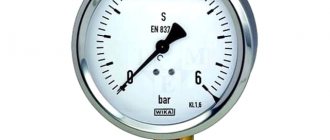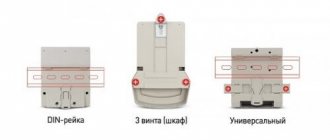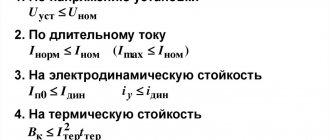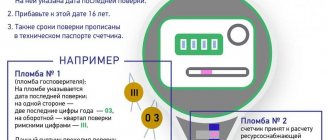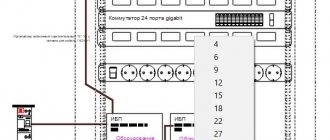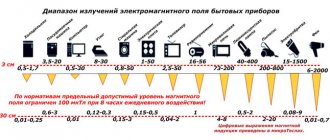What is the accuracy class of an electric meter and why does it matter? The accuracy class of a metering device (CT) corresponds to the maximum permissible error when measuring electricity. The value is expressed as a percentage: for example, class 2.0 means ±2% measurement error. The accuracy class of the electricity meter is written in the device passport or on the body in a circle.
Different measurement errors are allowed for different categories of consumers. Thus, the requirements for the accuracy of the device for electricity producers, individuals and the input of an apartment building will be different. All this information is given in Government Decree No. 442 of May 4, 2012, entitled “On the functioning of retail electricity markets...”. We present a brief summary from this voluminous document so that you do not have to waste time searching for data on the class of active electricity meters.
| Consumer category | Voltage class | Accuracy class |
| Electrical Energy Manufacturer | any | 0.5S and above, with measurements of hourly consumption volumes, storage >90 days |
| Consumer of more than 670 kW of power | ||
| Power consumption less than 670 kW | more than 110 kV | 0.5S and above |
| less than or equal to 35 kV | 1.0 and higher | |
| Entries of multi-apartment residential buildings | any | 1.0 and higher |
| Individual | 2.0 and higher |
In practice, it happens that store consultants give incorrect recommendations on choosing a meter, overestimating your real needs for the CT parameter. It’s not surprising, because they are interested in maximum sales income, and not attention to the buyer’s budget. And even “energy suppliers,” when they enter into a contract with a client, specifically exceed the requirements for the accuracy class of the electricity meter in the technical specifications.
We still advise you to check the accuracy class of the electric meter according to the law and use official data, asserting your rights if necessary.
Requirements for the accuracy class of electricity metering devices are enshrined in RF PP No. 442
The obligation of consumers of utility resources to equip their premises with individual metering devices is prescribed in several regulatory legal acts of the Russian Federation. For example, owners must install an IPU to comply with the requirements for the energy efficiency of an apartment building (Part 9 of Article 11 No. 261-FZ) and to determine the volume of individual consumption of utility resources (Clause 80 of RF PP No. 354).
No. 261-FZ and RF PP No. 354 also stipulate that apartment buildings, if technically possible, should be equipped with common building meters for utility resources (Part 7, Article 13 No. 261-FZ, clause 80 of RF PP No. 354). This requirement applies to the accounting of all utility resources, including electricity.
The requirements for what electric energy meters installed in apartment buildings should be are set out in RF PP No. 442. Thus, according to clause 138 of RF PP No. 442, metering devices with an accuracy class of at least 2.0 must be installed in the owners’ premises.
Moreover, before the entry into force of RF PP No. 442, communal meters installed in apartment buildings could also have an accuracy class of 2.0 and higher. But, in accordance with the requirements of clause 138 of RF PP No. 442, from June 12, 2012, ODPU of electricity must have class 1.0 and higher.
Can the management authority charge residents an additional fee for replacing the ODPU
11370719
Types of electricity meters
Induction
Induction is a device familiar to almost everyone. Their characteristic feature is a constantly rotating wheel behind transparent glass. It spins at different speeds and depends on the electricity consumption. The higher it is, the faster the wheel spins.
The readings can be seen on special reels with the numbers depicted. Its operating principle is as follows. The design has 2 coils. One of them is a voltage coil. It limits alternating current and also serves as a kind of barrier to various types of interference.
Its other function is to create a magnetic flux, which is equivalent to the voltage passing through it. The second coil is called the current coil. It also produces a magnetic flux, but only it is proportional to the strength of the current.
Both magnetic fluxes eventually penetrate through a special aluminum disk. Since they have a parabolic trajectory, they pass through the above-mentioned obstacle 2 times. Due to this, forces arise that cause the aluminum disk to spin.
As a result, the axis on which it is located acts on those same drums with numbers through a gear-screw drive. Thus, the readings depend on the rotation speed of the aluminum disk, and this, in turn, depends on the magnetic fluxes that are created by the coils.
As a result, the higher the voltage in the electrical network, the larger the numbers on the reels will be. Such meters are quite widespread even in the age of high technology.
Their advantages include:
- High reliability.
- Durability.
- Absolute independence from random voltage surges.
- Low price.
However, they have several disadvantages:
- Low accuracy class.
- The actual absence of any protection against electricity theft.
- High electricity consumption by the meter itself.
- Inevitable increase in error at low loads.
- Large overall dimensions.
Electronic
Electronic ones are more profitable these days and are used somewhat more often. They are superior to induction ones in terms of accuracy and make it possible to take into account such an indicator as multi-tariff.
This type of meter operates by converting an analog signal that comes from an electric current sensor. The device turns it into a digital code, which is numerically equal to the energy consumed. Then the received code is decrypted in the microcontroller and after that the readings can be seen on the digital screen.
An electric type meter has a much larger number of advantages than its induction counterpart, these include:
- High class of accuracy.
- Multiple tariffs.
- Measuring the consumption of all types of electricity.
- Storing all readings.
- Ease of information availability.
- When attempting to steal, unauthorized access is recorded.
- Possibility to take readings from the device remotely.
- Small overall dimensions.
A few disadvantages include:
- High sensitivity of the device to voltage changes.
- Relatively high cost
- Difficult to maintain and repair.
The accuracy classes of IPU and ODPU differ
The accuracy class of an electricity meter is the maximum error that may occur when measuring electrical energy consumption. The accuracy class is expressed as a percentage: at 1.0 it is ± 1%, at 2.0 – ± 2%. That is, at 1.0 the measurements will be more accurate than at an error of 2.0.
The accuracy class of the PU must be indicated in its passport, as well as on the front panel of the meter: usually this figure is indicated in a circle.
At the same time, as stated in clause 142 of RF PP No. 442, if the consumer had an IPU with an accuracy class below 2.0 (most often 2.5) installed before May 2012, then it can be used until its verification period expires. Then it must be replaced by installing a new metering device that meets the requirements of clause 138 of RF PP No. 442.
The same requirements apply to the ODPU of electricity: if, before the entry into force of RF PP No. 442, a general house meter with an accuracy class below 1.0 was put into operation in the house, then it needs to be replaced only if it fails or the verification period has expired.
In new houses, all installed metering devices must comply with the requirements of RF PP No. 442: IPU must have an accuracy class of 2.0 and higher, ODPU - at least 1.0.
How to commission and seal an individual meter
17544413
How to choose an electric meter
When choosing the most suitable device, not only the accuracy class of the meter is taken into account, but also other characteristics. First of all, you need to determine the number of phases available in a given electrical network. To do this, you should inspect the cable connected to the machine installed at the input. If it is two-wire, then the network is single-phase, and if it has three conductors, then the network is, accordingly, three-phase.
Therefore, when purchasing, you need to choose a meter designed specifically for a single- or three-phase network. Single-phase meters cannot be used in three-phase networks, but three-phase meters can be installed in single-phase networks, one line for each phase of the device. In order not to confuse the devices with each other, the corresponding markings are applied to the body.
It is also necessary to take into account the magnitude of the load that will be affected during the operation of the meter. As a rule, the maximum power value of the consumers that are planned to be connected to the load is taken. This indicator is displayed on the meter body and for private houses it averages 60 amperes. If you plan to install and connect more powerful equipment, for example, electric boilers, in this case you may need a metering device of at least 100 A.
Quite often it becomes known in advance about the possibility of metering consumed electricity at several tariffs, depending on the time of day. In this regard, most often two-tariff devices are selected that separately record electricity consumption during the day and at night.
Sometimes the mounting of the meter becomes of great importance for owners when a new device needs to be installed in place of the old one in a standard electrical panel. In such cases, the overall dimensions of the device are also taken into account.
The authorities considered the differences in the accuracy classes of IPU and ODPU to be the reason for the increase in the volume of CDs on SOI
A group of management organizations did not agree with the requirements to install metering devices with different accuracy classes, that is, in measurement errors, in MKD. They filed an administrative claim with the Supreme Court of the Russian Federation demanding that clause 138 of the RF PP No. 442 be declared invalid.
The management organizations indicated that this paragraph contradicts Part 1 of Art. 1 of the Civil Code of the Russian Federation and Part 1 of Art. 1 Residential Complex of the Russian Federation. It also puts participants in relations to purchase and pay for actually consumed electricity in an unequal position. Therefore, the norms of clause 138 of the RF PP No. 442 violate the principles of equality of participants in civil legal relations and equality of participants in relations regulated by housing legislation in the ownership, use and disposal of residential premises.
The different operating mechanisms of IPU and ODPU lead to an increase in the difference between the readings of the general house meter and the readings of individual metering devices. The volume of resources consumed by the house for the purpose of maintaining common property significantly exceeds the standard and the costs of paying for it fall on the shoulders of the management company.
Due to the different errors of metering devices, the readings of which are taken into account when calculating electricity charges for citizens and for persons paying for the Kyrgyz Republic on SOI, a situation arises when payers are billed different amounts for the same amount of resource. All errors in metering devices are interpreted in favor of the residents of the house, which violates the principles of justice, integrity and equality.
Because of this, as the management organizations indicated in the lawsuit, they are forced to pay inflated amounts for electricity consumed to maintain the common property of owners in apartment buildings, which leads to a deterioration in their financial situation and an increase in the amount of debt to RSO.
Pros and cons of installing smart meters in an apartment building
247805
Which counter to choose
Sometimes old meters still fail, or the energy supply organization requires the meter to be replaced. In matters of choice, you should rely primarily on the technical specifications issued by the supplier, since he has the right not to accept into operation equipment that does not meet his requirements.
If the consumer is not limited in choice, then he should purchase an inexpensive model, perhaps even an induction electromechanical type, but preferably a new one.
Options when previously used meters are installed also have the right to life, however:
- Without knowledge of electrical engineering, it is impossible to determine the operating condition.
- The electricity supplier has the right to require verification of such a device, performed at the subscriber’s expense.
New meters are verified at the manufacturer, so they are immediately ready for installation into the power grid. You should also pay attention to electronic digital multi-tariff models, especially if the consumer is connected to a three-phase line. In this case, it becomes possible to save significantly during the so-called grace periods, when electricity is sold at reduced prices.
Differentiation of PUs by class protects consumers from unnecessary energy costs
The Supreme Court of the Russian Federation, having analyzed the norms of the contested clause 138 of the RF PP No. 442, noted that the requirement to use metering devices of a certain accuracy class for metering electrical energy complies with the current legislation.
So, according to Part 1 of Art. 13 No. 261-FZ, consumed energy resources are subject to mandatory accounting using metering devices, and the requirements for their characteristics are determined in accordance with the legislation of the Russian Federation.
Measuring instruments of an approved type that have been verified and ensure compliance with established requirements are allowed for use, including mandatory metrological requirements for measurements, mandatory metrological and technical requirements for measuring instruments (Part 1, Article 9 No. 102-FZ).
In this case, the accuracy classes of metering devices are determined in accordance with technical regulations and other mandatory requirements established for the classification of measuring instruments.
The use of meters of accuracy classes 0.5, 1.0 and 2.0 to measure the volume of electricity consumed complies with the requirements of GOST 31819.11-2012 (IEC 62053-11:2003).
The owners of premises in an apartment building and the management unit are not parties to the same agreement concluded with the resource supply organization, and do not have the same legal status:
- premises owners enter into an energy supply agreement with RSO;
- The management company enters into an agreement with the RSO for the supply of resources for the maintenance of the common property of the owners in the apartment building.
At the entrance to the MKD, the metering device records a large volume of electricity: the total volume of individual consumption and CR on the SOI. The higher the volume of resource consumption, the higher the error value.
Therefore, the accuracy class of a common house metering device is higher than the requirements for such a characteristic of the IPU. Such differentiation is aimed at protecting the interests of citizens living in apartment buildings: they should not incur additional costs caused by greater errors in accounting for utility resources.
The Supreme Court of the Russian Federation came to the conclusion that clause 138 of the RF PP No. 442 does not violate the principles of equality of civil transactions and participants in relations regulated by housing legislation. The management organizations' claim was rejected.
Determination of error
Owners of measuring instruments are interested, first of all, in the maximum error characteristic of a pressure gauge. It depends not only on the accuracy class, but also on the measurement range. Thus, to obtain the error value, you need to make some calculations. For example, for a pressure gauge with a measurement range of 6 MPa and an accuracy class of 1.5, the error will be calculated using the formula 6*1.5/100=0.09 MPa.
It should be noted that only the main error can be calculated in this way.
Its value is determined by ideal operating conditions. It is influenced only by the design characteristics, as well as the assembly features of the device, for example, the accuracy of the graduation of divisions on the scale, the friction force in the measuring mechanism. However, this value may differ from the actual value, since there is also an additional error determined by the conditions in which the pressure gauge is operated. It can be affected by vibration of the pipeline or equipment, temperature, humidity level and other parameters.
Also, the accuracy of pressure measurement depends on another characteristic of the pressure gauge - the magnitude of its variation, which is determined during verification. This is the maximum difference in meter readings identified from the results of several measurements.
The magnitude of the variation largely depends on the design of the pressure gauge, namely on the method of balancing, which can be liquid (pressure from a liquid column) or mechanical (spring). Mechanical pressure gauges have a more pronounced variation, which is often due to additional friction due to poor lubrication or wear of parts, loss of spring elasticity and other factors.
Source:
On a note
The Supreme Court of the Russian Federation, in its decision in case No. AKPI 18-1304, indicated that the difference in measurement error between IPU and ODPU is caused by different amounts of electricity that these devices record. The higher the volume of the metering device, the greater the error, therefore, the higher the accuracy class of the metering device must be so that it records the actual volume of resource consumed.
Management organizations that note an increase in excess resource consumption for the maintenance of common property of owners in an apartment building should remember the factors influencing this indicator:
- non-transfer of IPU evidence by owners;
- faulty information control systems, including those whose operation was subject to unauthorized interference;
- theft of utility resources bypassing the IPU;
- inefficient use of resources in common areas (for example, the light in the entrance is on all day).
To combat these factors, the management authority, together with the RSO, must develop a strategy to eliminate them and involve the MKD Council, active owners and residents of the building in the work.
Rationing
Accuracy classes of measuring instruments tell us information about the accuracy of such instruments, but at the same time it does not show the accuracy of the measurement performed using this measuring device. In order to identify in advance the error in the instrument readings, which it will indicate during measurement, people normalize the errors. To do this, they use already known normalized values.
Rationing is carried out according to:
- absolute;
- relative;
- given.
Formulas for calculating absolute error according to GOST 8.401
Each device from a specific group of devices for measuring dimensions has a certain value of inaccuracies. It may differ slightly from the established standardized indicator, but not exceed the general indicators. Each such unit has a passport in which the minimum and maximum error values are recorded, as well as coefficients that have an impact in certain situations.
Download GOST 8.401-80
All methods of standardizing measuring instruments and designating their accuracy classes are established in the relevant GOSTs.
